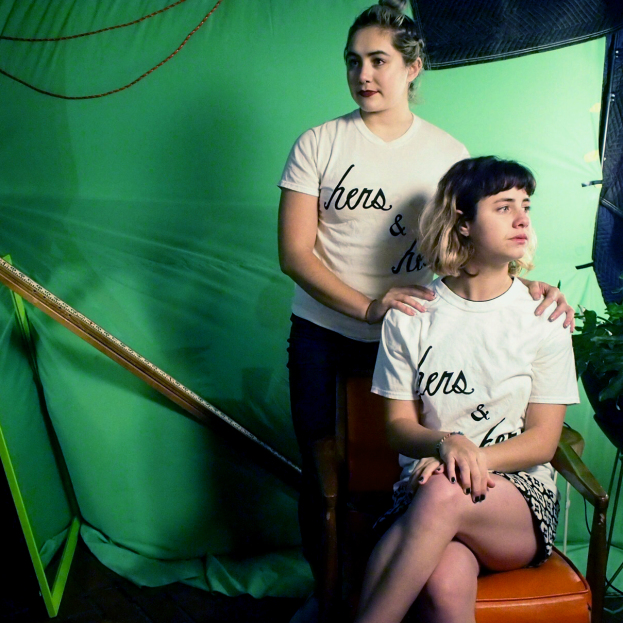
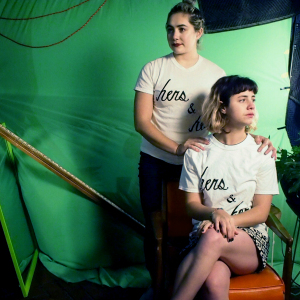
Hey, We’re hers and hers. A new queer feminist dance collective in San Francisco We (Courtney King and myself) craft dance-theater with strong woman-identified performers, we write epic poems that make their way into our dances, we blog, we interview our local communities as fieldwork, we conduct an ongoing 35mm film portrait series, we Instagram, and we feature women we admire in an online series called Choreographer Playbook. And we’re just getting started.
We first encountered each other in Katie Faulkner’s modern class at the University of San Francisco’s Performing Arts & Social Justice Program. We began to ask a lot of questions about the relationship between performing and social justice: performing bodies, genders, identities, cultures, norms and histories. We collected a series of these questions in July of 2015 for Emmaly Wiederholt’s Stance on Dance blog — we’ve decided to revisit some of them here, almost a year later.
FIRST,
We asked this original set of questions in 2015; questions to circle around in creative process, in watching performance, and in life in general:
- What is feminism? What is feminism
in dance? How can making dance be a feminist act? - How are men included in a feminist methodology? How are those with non- conforming gender identities included? How can we represent ourselves and others? Where do we see inequality?
- Is feminism undermined or strengthened by dance we see today?
- What can we uncover from experiences/ the body/ideas to ‘an audience?’ How can the personal be shared/related to?
- Where is the intersection of the personal and the political?
- What norms are we experiencing that we disagree with? How are we doing? Are we okay? Are you okay?
- Where does love come from? How do we ask for it?
THEN,
We asked again.We returned to where we first met and shared our inquiries with Katie, in order to gain some perspective. We’re all in new (but varied) chapters, working on respectively new projects. Katie Faulkner’s little seismic dance company has their 10th anniversary home season, for which she’s creating Memoir (a solo on herself), an ensemble piece for five women titled Don’t Worry Baby, and a duet from 2014 with Chad Dawson. For hers and hers, 2016 has been ODC’s Pilot 67, and will include a few more iterations of our newest (un)apologetic quintet. Then we’ll take a dance “sabbatical” for a new photo essay about “getting ready” and a seminar with our collaborators for reading/research on queer theory.
So, we asked again with our longtime teacher and choreographic mentor, asking her to join our chorus of questions; to maybe arrive at something…
Katie Faulkner: I ask myself a lot of these questions, too. And I feel my answers are always evolving. Engaging in the thought process around them, I have definitely worked in my own personal and political life to try not to get too rigid about any one set of ideas. And to recognize how fluid and how constantly shifting a lot of our understandings around these things are. But, I definitely believe that making dance can be a feminist act, absolutely.
hers and hers [Melissa]: I’m curious about what your feminism is. For today, fluid.
KF: My sense is that [feminism’s] roots are in equity, and I still think that’s true—but I think it’s evolved over time to include conversations about more fully making space— cultural, social and political space—for the fullness of a woman’s knowledge, experience, sense of themselves, agency, power, safety.
h&h: All those descriptive words make me think how connected they all are to dance.
KF: Yes. I do think about and am interested in creating classroom spaces that are basically feminist spaces. Regardless of the gender identities represented in the room. At its core it’s about honoring the whole person by creating safe and robust places for people to really know themselves. All of themselves, as much as possible. I feel like dance is a really unique meeting point for parts of self that don’t come into contact under different circumstances and it’s powerful in that way! … There are so many embodied skills in dance that ask for attentiveness, for listening, empathy, connection, attunement—that in many ways ask for humane perspectives of ourselves and others.
h&h: Maybe it’s a general perception of the word political, and how the value system in art-making leans towards a definition of political performance as more overt, public displays of political issues. Work that is private or personal—or even what happens behind the scenes in home or studio spaces—doesn’t register instantly as really political. I think that the private, personal practices CAN be just as political as… rally cries.
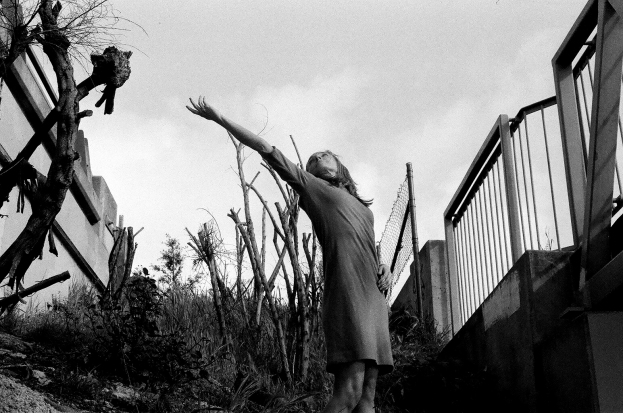
KF: I absolutely agree. There are so many ways to work politically… My relationship to dance-making is typically not driven by trying to create work around a central idea or a central agenda. I actually engage with making work as a way of understanding the world better. Of understanding the world inside of me, and me inside of the world.
I’m aware that by choosing to be a dance maker, choosing this career, it feels like a very political choice… women deciding to take some room, to define her physical space, and to ask for a kind of attention to how she chooses to be represented and seen. Choosing work that’s outside of the mainstream, margins of commerce and commodification.
h&h: Right. A transactional way of thinking, versus making something that isn’t as tangible: that is risk. In creating a rehearsal space to work with five dancers, we try to create a liminal space outside of everyday life—to suspend how society often determines the rules.
KF: Everyone has a relationship to risk. We talk a lot about “risk” [in art]. There’s a way I think the idea of risk can be very extrinsically motivated.. When in fact for me, getting in front of a group of people and moving in front of them, and revealing my decisions— just that vulnerability is extremely risky.
h&h: Not even creative risk.
KF: Yeah. Right. That exposure. That’s risky to me. I don’t think we honor that enough.
h&h: It’s a given: ‘of course, she’s a dancer…’
KF: Right,‘there she goes again…’
h&h: ‘of course she’s gonna do that up there’
KF: But, the creative risks I’m able to take are not unrelated to my privilege—white, able-bodied woman working within a generally supportive community. The risks I take are not life and death, and that’s obviously not true for all artists working in the world.
… One of the things you said in your Stance on Dance article that I really liked was about the body. Yes, the body is culture. The body is history. The body is family. The body is relationships. The body is choices. The body is anatomy. I think there’s a way of acknowledging that in process. Going into the room and harnessing the deep knowledge that the body possesses is really profound—if you’re engaging with asking the body, sort of interviewing the body. There are ways of engaging with movement-making that are about adhering to known vocabularies, and there are ways of engaging with movement creation that are really about a process of trying to unearth and understand something that the body knows.
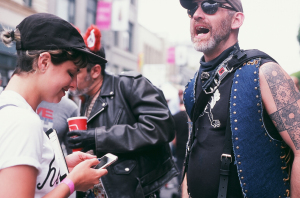
h&h: For us, asking questions is a natural strategy as we try to stay informed by what’s already there. It comes out conducting inter- views in public, chatting with our dancers in rehearsals, talking to mentors. This urge to ask helps us take inventory of what’s actually relevant. For instance, at the 2015 Pride Parade, how incredibly informative it was to ask people of all ages and genders and races and sexualities, to react in real time to: “would you consider yourself a feminist? What do you think of that word?” … and be totally surprised at each response. Sometimes asking questions feels like the only way that we really know for sure how to operate.
KF: I love that you’re doing that. It makes me realize how much I could gain from interviewing my mentors. And my students! Looking ahead and looking behind. To the side. What I like about that is it engages with uncertainty… for me art-making is this exquisite opportunity to engage with the unknown. I really like that. I really like going into a process not knowing what I’m gonna do… I make work in order to know things. I don’t know things and then try to make work about it… How do you think about it?
h&h: I think it’s about making space for people to reach their own conclusions. How might a dance ask the audience a question and then let them answer it?
Do you feel like your solo-making process right now, is like an interview, but towards yourself?
KF: Yeah, I do. Turning 40 this year, was kind of big…surprising how much that affected me. I know it’s not that old, but it has made me reflect a lot on who I really am as a mover, what I’ve inherited, what I agree with, what I don’t agree with… It’s actually been a slow process of stripping everything away and treating this solo process as an interview:
What does it mean to have been a dancer for 36 years of my life?
How does it define me, or not?
Have I really found a way to make this art my own?
What experiences have I had that make me see the world the way that I do? What’s my own relationship to my own body and my own power?
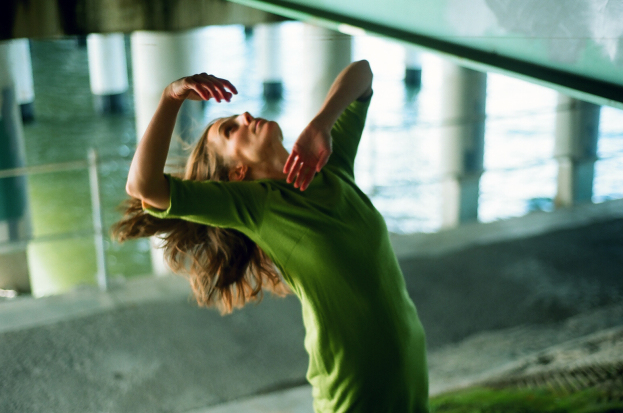
All of the questions mean having to go way way way way back.
I really credit my teaching, as I was growing up [in North Carolina], my training that I received was from this incredible collective of women. I have been doing creative movement, modern dance, choreography and improvisation since I was four years old. I didn’t start doing ballet ‘til I was maybe eight, and I took it one day a week from a modern dancer. And, I danced in a multigenerational dance company from the time I was eight until I was 18.
I’ve been surrounded by women who have created their own dance lives since I was a little kid. I’ve been surrounded by women of every generation making their own decisions about the role that dance plays in their lives. And creating situations for themselves where THEY will thrive surrounded by a loving community of people. At every stage of my life, pretty much, I have been surrounded by women who have chosen dance, and in a way that was very much on the fringes of what was main- stream. They were hardworking, entrepreneurial, and creative. And I think there’s a part of me that takes it for granted because it’s been around me for so long. And I only know now how deeply, deeply blessed I was to have those role models. And how feminist the context of my dance upbringing was. Without my really knowing that that’s what it was.
So when I decided to start making my own work, it was terrifying, but it also felt like a natural progression, having been surrounded by women who essentially said:
Of course this is what you do. If you want to dance, go and do it. Make what you want to make. That’s what you do.
h&h: It was a huge aha! for us, seeing that as a possibility in San Francisco. You, and so many women dance artists have multiple modes or ways of working, as women and performers and choreographers and teachers. I think it’s a huge part of why we want to be here and invest as artists here.
KF: That’s wonderful! I do think that young girls, young women, young people—need examples… need models of thriving and self-actualizing. I feel so fortunate that I have women older than I who I’ve watched navigate the eld—who have found ways of building really rich lives for themselves without having children or maybe without getting married or following the well-worn cultural path that we’re supposed to follow. I feel so lucky that I’m in an area where, to have chosen not to have children, to have chosen to pursue the life and career of an artist, isn’t such a marginalized idea. That I’m surrounded by people everyday who are making different choices is incredibly empowering. To your point, having models of people who are coming into their own in robust, self-determined ways is so so SO important. And political. And feminist. It’s all of those things. It offers up a kind of permission. And that’s incredibly powerful.
NOW, HERE,
We reflect. On this safe and robust time with Katie, that let us think aloud on feminism, risk, space, political x personal, and power. As we tether ourselves to the vastness of larger feminist and dance conversations / communities, this kind of dialogue helps us grow. It informs the future of hers and hers.
Dance-making for us has been an act of questioning. Interviewing the body—rich, knowledgeable, enough. Feminism creates space for these bodies. Feminism involves race, class, gender, culture, history, lineage— it has to, otherwise it’s nothing; it’s a shared her. It’s personal and private and also it’s a communal uplifting. Feminism questions the way things operate. It acts on how we each can work towards power. In uncertainty and inquiry is power. A question can open the door to where an answer is housed.
Find the un-excerpted interview with Katie at hersandhersf.wordpress.com / @hersandhers_sf. Read the original essay at stanceondance.com.


